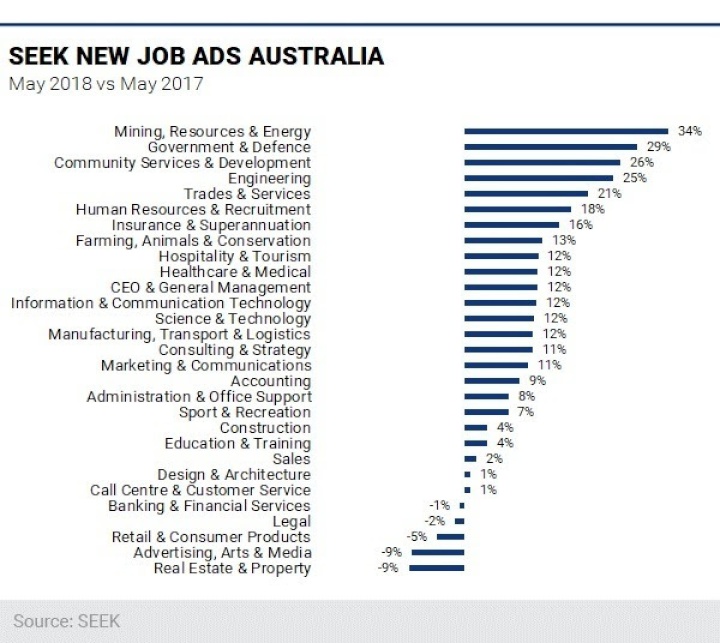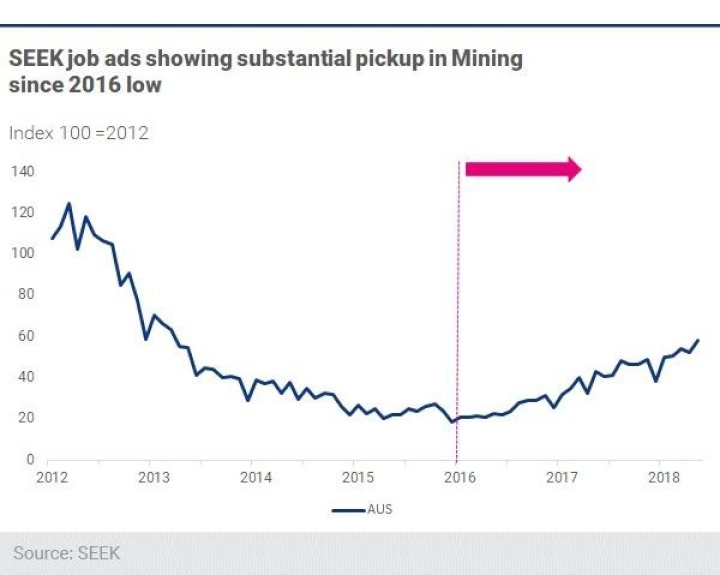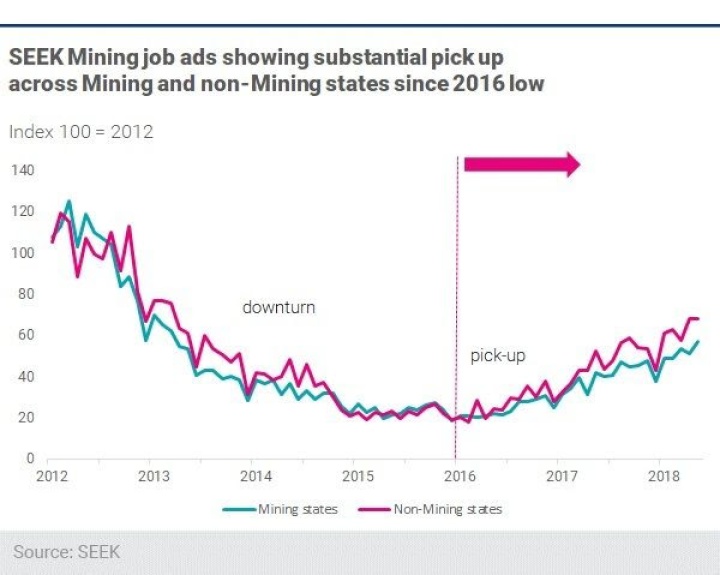Aust: Employment Data - Mining shows strong recovery
Employment Data Report
Mining shows strong recovery as permanent roles
increase
14 June
2018
• SEEK job ads up 10.7 per cent in May
compared to this time last year
• Mining, Resources &
Energy and Government & Defence experiencing highest growth
rates
• Australia’s Mining sector seeing significant
increase in permanent roles across the states
National
new job ads recorded a year on year (YoY) rise of 10.7 per
cent in May according to the latest data from SEEK. The
industry that recorded the largest positive growth in job
ads this month was Mining, Resources and Energy which saw a
34 per cent increase in May when compared to this time last
year. This was closely followed by Government and Defence
where job ads were up 29 per cent YoY, and Community
Services and Development, which recorded a 26 per cent
increase in job ads compared to twelve months ago.
New job ads in Community Services and Development grew in almost every state, the highest growth was recorded in South Australia (39 per cent YoY), followed by Queensland (37 per cent YoY) and Victoria (28 per cent YoY). Despite lower growth (23 per cent YoY), New South Wales was the biggest contributor to the sector this month.
Kendra Banks, Managing Director ANZ, SEEK, said: “The Community Services and Development sector has enjoyed strong job ad growth in recent months. As well as seeing the third biggest job ad growth in May, the sector experienced the second highest growth nationally in April, with job ads up 49 per cent compared to April 2017.”
Kendra points to the national roll out of the NDIS having an ongoing positive impact on job ad growth in this sector. “The growth in Community Services and Development sector continues to be driven by roles in aged care and disability support as the NDIS is rolled out across the country.”
The industries that saw a decrease in job ads compared to May 2017 were Real Estate and Property and Advertising, Arts and Media, which both saw job ads fall 9 per cent YoY. Both sectors have been struggling recently, with Advertising, Arts and Media jobs falling in almost every month of 2018.
Kendra said: “Continued job cuts across Australia’s media landscape in the last twelve months appear to be having a detrimental impact on the sector, with job ads decreasing in every month this year except April. With more job cuts announced in June this trend is likely set to continue.”
Retail & Consumer Products job ads also took a dip in May, posting a decline of 5 per cent YoY compared to May 2017. Despite the sector posting better than expected sales in April, the ABS reports that it has been an overall slow year for the retail sector, with sales only growing 2.6 per cent in the 12 months to April 20181.
Kendra added: “A lot of retail growth appears to be driven by online players, with online competition in the sector heating up. This could have an effect on the number of new jobs opportunities available on the shop floor with bricks and mortar retail struggling to find its footing in an increasingly digital world.”
Figure 1. SEEK new job
ads
INDUSTRY FOCUS: MINING
Nationally SEEK job ads in the mining sector increased 34 per cent YoY in May, building on the substantial pick up in job ads since 2016 when the sector began to recover after four years of decline.
Mining is the third largest contributor to the Australian economy, behind Services and Construction, contributing for 6.9 per cent of Gross Domestic Product2. The sector currently employs approximately 226,500 people (ABS trend data), full time and part time, which is around 1.8 per cent of the total workforce in Australia.
Figure 2. SEEK job ads in mining have experienced significant pick up since 2016

MINING ACROSS AUSTRALIA
This positive growth in job ads since 2016 can be found across both the mining states (NT, QLD, WA, NSW) and non-mining states (VIC, SA, TAS). The number of yearly opportunities in the mining states has increased by an average of 93 per cent from their low in 2016 and 109 per cent in the non-mining states in the same period.
Figure 3. Pick up in job ads in the mining and non-mining states since 2016

SHIFTING ROLES IN
MINING
During the mining
downturn between 2012 and 2016, alongside the loss of 55,000
jobs (ABS), there was a reluctance to hire permanent staff
in the sector, with the ratio of contract to permanent job
ads climbing steeply. However, SEEK’s data now shows that
this trend is reversing: since mid-2016 the number of
permanent job ads has been increasing, which suggests a
renewed confidence in the sector.
There has also been a shift in the type of jobs being advertised when you compare job ad data from 2018 to job ads during the 2012 boom. There is a notable increase in Opex over Capex related job ads that reflects wider industry trends.
Kaixin Owyong, an Economist from NAB comments on this shift of focus from Capex to Opex hiring: “During the mining boom, there was a huge amount of investment that significantly increased the mining capital stock. This phase also required more exploratory roles for potential greenfields investment. Immediately after the boom, mining firms were focusing on keeping costs low, and put off maintenance work. However, more recently, commodity prices have lifted and firms are spending again on maintenance roles, which are needed to keep the (much larger) capital stock running.”
Download Employment Data Report
MEDIA NOTE: When reporting SEEK data,
you must attribute SEEK as the source.
--
END--


 Parrot Analytics: A Very Parrot Analytics Christmas, 2024 Edition
Parrot Analytics: A Very Parrot Analytics Christmas, 2024 Edition Financial Markets Authority: Individual Pleads Guilty To Insider Trading Charges
Financial Markets Authority: Individual Pleads Guilty To Insider Trading Charges Great Journeys New Zealand: Travel Down Memory Lane With The Return Of The Southerner
Great Journeys New Zealand: Travel Down Memory Lane With The Return Of The Southerner WorkSafe NZ: Overhead Power Lines Spark Safety Call
WorkSafe NZ: Overhead Power Lines Spark Safety Call Transpower: Transpower Seeks Feedback On Electricity Investment Short-list For Upper South Island
Transpower: Transpower Seeks Feedback On Electricity Investment Short-list For Upper South Island Commerce Commission: “Cheating The System” – Sentencing In Country’s First Criminal Cartel Case
Commerce Commission: “Cheating The System” – Sentencing In Country’s First Criminal Cartel Case



